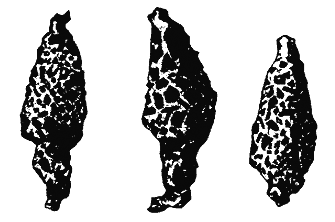
Fig. 54-1. Type specimens of R. subfusiformis, from Earland (1933) ORIGINAL DESIGNATION: Reophax subfusiformis Earland emend. Höglund, 1947 TYPE REFERENCE: Earland, A., 1933. Foraminifera. Part II. South Georgia. Discovery Reports, 7, p. 74, pl. 2, figs 16-19. see also: Höglund, H., 1947. Foraminifera in the Gullmar Fjord and the Skagerak. Uppsala Univ. Zool. Bidr., 26, pp. 77, 82. TYPE SPECIMEN: Deposited in the Heron-Allen and Earland Collection in the British Museum (Natural History) in Slide ZF 3487. The lectotype, designated herein is the specimen illustrated by Earland (1933) in pl. 2, fig. 17. TYPE LEVEL: Recent. TYPE LOCALITY: Originally described by Earland (1933) from Discovery Station D144, 155-178 m near South Georgia. Höglund (1947) redescribed this form from the Gullmar Fjord, the Skagerak, and the North Sea. All of Höglund's stations are between 30 and 220 m depth. DIAGNOSTIC FEATURES: Test comprised of 2 to 4 chambers with a large, tapering, fusiform last chamber. Chambers increase in size rapidly, and the last chamber sometimes forms the bulk of the test. The test may be straight or slightly arched, with depressed sutures. The aperture is terminal, at the end of a wide, prolonged neck. Wall is thin, typically constructed of poorly sorted grains, which may include rather large sand grains and occasional sponge spicules. The test is generally compressed. SIZE: Earland (1933) reported specimens from South Georgia up to 2.2 mm length. Modern specimens from the Norwegian Fjords can be up to 2.6 mm in length. Fossil specimens are much smaller, and generally do not exceed 1 mm. SYNONYMS: See Höglund (1947). Reophax scorpiurus Montfort (pars). Goës, A. 1894, p. 25, pl. 4, figs. 166, 167 [by original designation]. OBSERVED OCCURRENCES: Reophax subfusiformis is observed in Recent sediments at high-latitude stations throughout the Atlantic and Southern Ocean (Goës, 1894; Earland, 1933; Höglund, 1947). As Reophax scorpiurus, Goës (1894) reported it from 140 m in the Gullmar Fjord (Norway). Pfleger (1952) listed it as Reophax curtus from the Gulf of Maine off Portsmouth New Hampshire, where it was reported to be the dominant species. Earland (1933) originally described it from 26 stations in the South Georgian sector if the Southern Ocean, and Earland (1934) subsequently listed it from 42 stations in the area of the Falklands Islands, noting it is widely distributed but rare at most localities. Pflum (1966) reported it from 265 m depth in the Ross Sea, and Schröder-Adams (1990) reported it as a dominant species at ODP Sites 739 and 741 in Prydz Bay (412 & 561 m). Hess (1998) reported it from 371 to 4307 m in the South China Sea. Fossil specimens have been reported from the the Eocene Lyulinvoskaya Formation of the Western Siberian lowlands (Freiman, 1970), and from the Paleogene of Leg 38 DSDP Sites in the Norwegian - Greenland Sea (Verdenius & Van Hinte, 1983). It was reported from the Miocene of offshore Cabinda (West Africa) and the Transylvanian Basin by Preece (1999). KNOWN STRATIGRAPHIC RANGE: Late Cretaceous to Recent. BATHYMETRY: Neritic to abyssal. REMARKS: The large, fusiform last chamber of R. subfusiformis resembles Lagenammina, and care must be taken to separate the two forms. Pfleger (1952) and Parker (1952) listed R. subfusiformis as a junior synonym of Reophax curtis Cushman, 1920, which differs in its more rapidly enlarging chambers and lack of a distinct neck. In our opinion, the specimens illustrated by Parker are closer to the typical S. subfusiformis.  Figure 54-2. Specimens from the upper Eocene (Lyulinvoskaya Formation) of Western Siberia, from Freiman (1970). Specimens from Siberia illustrated by Freiman (1970) display variability in the nature of the wall. Some specimens use only relatively large quartz grains, while others are less selective and use large grains and occasional sponge spicules embedded within a matrix of smaller grains. ILLUSTRATIONS: Plate 54 - Reophax subfusiformis Earland, emend. Höglund Figs. 1-2. Recent, Paralectotypes from the Earland Collection, BM(NH) Silde ZF3487, 1. lectotype, 2. paralectotype; Figs. 3-4. Recent. Oslo Fjord; Fig. 5. Miocene, ODP Site 646, Labrador Sea, Sample 646B-47X, CC; Figs. 6-7. Lower Paleocene, Lizard Springs Formation of Trinidad, Well G-287, 3320'; Fig. 8. Maastrichtian, Labrador Margin, well Gudrid H-55, 8670'. 
|